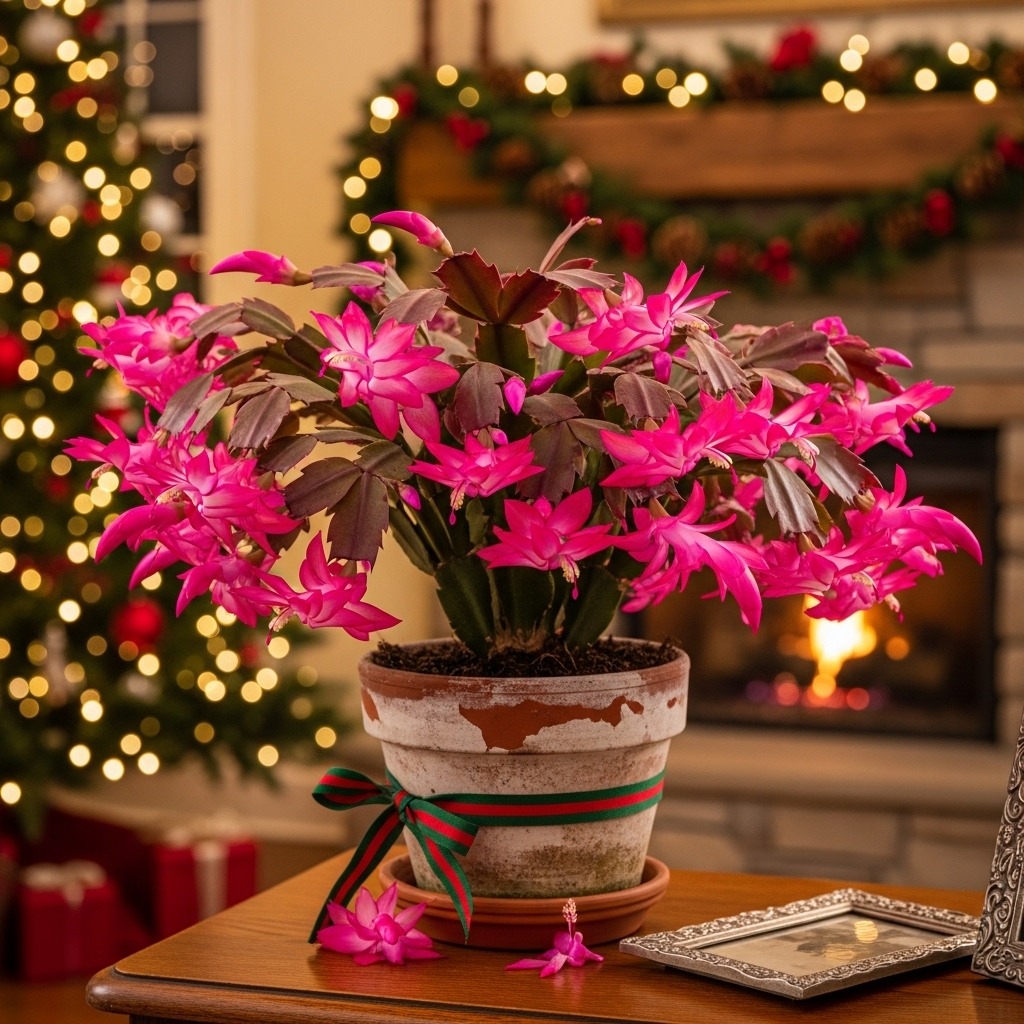During the holiday season, it’s easy to confuse the Christmas cactus and the Thanksgiving cactus — two beautiful plants that often bloom around the same time.
While they look very similar at first glance, these festive succulents have a few subtle differences that make each one unique.
Whether you’re a plant lover or just curious which one you have, this guide will help you easily tell them apart by their leaves, flowers, and blooming times.
A Quick Overview of Both Plants
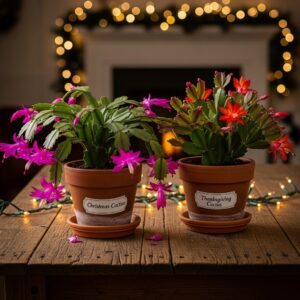
Both the Christmas cactus (Schlumbergera x buckleyi) and the Thanksgiving cactus (Schlumbergera truncata) belong to the same plant family and originate from the tropical rainforests of Brazil.
Unlike typical desert cacti, they grow naturally on tree branches, where they absorb moisture and nutrients from the air.
Because they thrive indoors and bloom during the colder months, both are extremely popular as holiday plants — often passed down through generations as family heirlooms.
However, they are two distinct species with differences in leaf shape, flower direction, and bloom timing.
Learning to spot these features will help you identify and care for your plant more effectively.
The Most Noticeable Difference: Leaf Shape
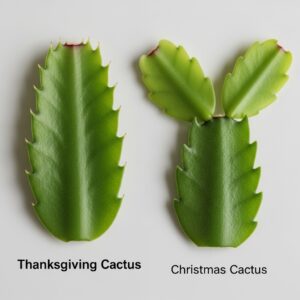
The easiest way to tell them apart is by looking closely at their leaf segments (cladodes) — the flat, jointed stems that make up the plant.
Thanksgiving Cactus (Schlumbergera truncata):
The leaf segments have pointed edges with small, claw-like tips.
Each segment looks jagged or spiky, almost as if it has tiny teeth along the sides.
Because of these “hooks,” it’s sometimes nicknamed the Crab Cactus.
Christmas Cactus (Schlumbergera x buckleyi):
The leaf segments are smoother and rounder with gently scalloped edges instead of sharp points.
They appear softer and more curved, giving the plant a delicate look compared to its Thanksgiving counterpart.
Simply put, pointed edges = Thanksgiving cactus, and rounded edges = Christmas cactus.
Flower Shape and Direction
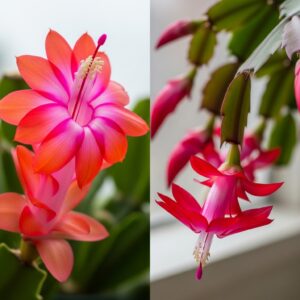
Another clear difference lies in how their flowers look and grow.
-
Thanksgiving Cactus:
Its flowers are more upright and asymmetrical, with long, narrow petals that curl backward, giving them a tubular appearance. The blooms tend to point outward or upward, showing off their bright, exotic shape. -
Christmas Cactus:
The flowers of the Christmas cactus are more symmetrical and droopy. The petals curve gently and hang down like a bell, creating a softer and more cascading look — perfect for hanging planters or decorative pots.
Both plants produce stunning blooms in shades of pink, red, white, and purple, but once you’ve seen both side by side, you’ll easily spot the contrast in petal shape and posture.
Blooming Season: Thanksgiving Comes First

The timing of their blooms is another clue.
-
Thanksgiving Cactus: Usually blooms from late October through November, making it the first of the two to flower. It often reaches full bloom just before or during Thanksgiving — hence the name.
-
Christmas Cactus: Typically blooms a few weeks later, from late November through January, aligning perfectly with Christmas and New Year celebrations.
If your cactus is blooming around Thanksgiving, it’s likely the Thanksgiving cactus.
If it blooms closer to Christmas, you probably have the Christmas cactus.
Stem Growth and Overall Shape

Over time, the Christmas cactus tends to grow more gracefully, with arching, trailing stems that look soft and flowing.
This makes it especially beautiful in hanging baskets or tall planters.
The Thanksgiving cactus, on the other hand, grows a bit more upright and structured, with stems that spread out rather than droop.
This gives it a fuller, more bushy appearance.
Hybrid Confusion: Why They’re Often Mixed Up
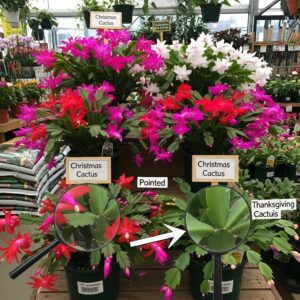
Most plants sold in stores during the holiday season are actually Thanksgiving cacti, even when they’re labeled as Christmas cacti.
This is because Thanksgiving cactus varieties bloom earlier and are easier for growers to get ready for sale in November and December.
True Christmas cacti (Schlumbergera x buckleyi) are less common commercially but can often be found in older family collections.
So, if you bought your plant from a garden center or supermarket just before Christmas — chances are, it’s actually a Thanksgiving cactus mislabeled as a Christmas cactus.
Caring for Both Plants
Despite their differences, both plants share nearly identical care requirements.
They prefer bright, indirect light, moderate humidity, and well-draining soil.
Water when the top inch of soil feels dry, but avoid overwatering.
To encourage blooming, provide cooler nighttime temperatures (around 55–60°F / 13–15°C) and at least 12–14 hours of darkness for about six weeks before the desired bloom time.
Both species can live for decades with proper care, rewarding you each year with dazzling blooms during the holiday season.
8. Quick Comparison Table
| Feature | Christmas Cactus | Thanksgiving Cactus |
|---|---|---|
| Scientific Name | Schlumbergera x buckleyi | Schlumbergera truncata |
| Leaf Shape | Rounded, scalloped edges | Pointed, jagged edges |
| Flower Shape | Drooping, symmetrical | Upright, tubular, asymmetrical |
| Bloom Time | Late November – January | Late October – November |
| Stem Growth | Arching, cascading | Upright, spreading |
| Commonly Sold As | Rare, often older varieties | Common in stores, mislabeled as Christmas cactus |
Whether you have a Christmas cactus or a Thanksgiving cactus, both bring a burst of color and joy to your home during the winter months.
The subtle differences in their leaves, flowers, and bloom times make each special in its own way.
No matter which one graces your windowsill, these tropical beauties are sure to become cherished parts of your holiday traditions — year after year.
